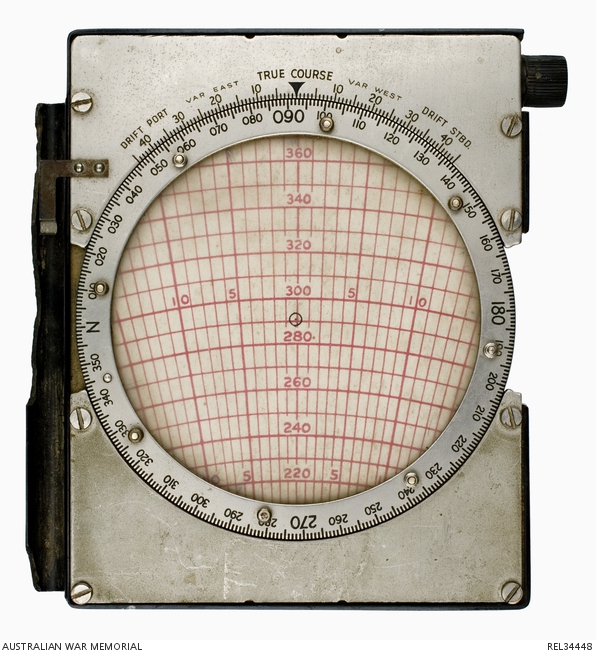| Places | |
|---|---|
| Accession Number | REL34448 |
| Collection type | Heraldry |
| Object type | Personal Equipment |
| Physical description | Aluminium, Bakelite, Celluloid, Paper |
| Maker |
Unknown |
| Place made | United Kingdom |
| Date made | c 1941-1945 |
| Conflict |
Second World War, 1939-1945 |
Navigational computer : Flight Lieutenant B J Mattingley, 460 Squadron RAAF



Royal Air Force issue Navigational Computer Mk III F* Ref No 6B/214 with Air Ministry markings. The computer, used to estimate True Course by allowing for aircraft speed, drift and altitude, is contained in a dark brown Bakelite case designed to be strapped to the user's leg (some of the fittings and the straps for this are missing). One side, covered with an aluminium plate stamped 'ISOTHERMAL CALIBRATION', has a rotating central dial and is calibrated to allow for calculations in nautical or statute miles, height in feet and temperature in centigrade.
The back of the computer is also covered with an aluminium plate which has a large circle cut from the centre covered with thick clear celluloid. Beneath is a paper grid, marked in red, which can be wound through, using a Bakelite knob on the side of the computer, so that different configurations can be utilised. A rotating aluminium dial around the grid is marked with 360 degrees and 'N'. Further markings around the outside of the dial allow for port and starboard drift adjustment. The computer is contained in brown cardboard box for a slightly earlier version of the instrument, also used in the Second World War, marked on the lid in black 'STORES REFERENCE No 6B/180 NAVIGATIONAL COMPUTER MARK III D* R. (N.)'.
Used by 432530 Flight Lieutenant Brian John Mattingley, who was born in Launceston, Tasmania in October 1914.
A teacher at the Armidale School in New South Wales, Mattingley enlisted in the militia on 9 July 1941. He was allocated the service number N276471 and served as a private in the legal section of Headquarters 2nd Australian Army. He was discharged on 1 January 1943.
Mattingley joined the RAAF in Sydney the next day. Accepted as a candidate for air crew he undertook training at Mt Gambier and at the Air Gunnery School at West Sale in Victoria, before transferring to 2 Air Navigation School at Nhill on 18 October 1943. After graduation and commissioning as a pilot officer he embarked from Sydney for England on 12 December 1943, arriving there at the end of January 1944.
Mattingley was posted to 460 Squadron RAAF on 9 May 1944 and promoted to flying officer. Between October 1944 and March 1945 he completed 36 operational sorties over Germany in Lancaster bombers. In 1945 he was awarded the Distinguished Flying Cross for completing 'numerous operations against the enemy, in the course of which he has invariably displayed the utmost fortitude, courage and devotion to duty.'
Mattingley was promoted to flight lieutenant shortly before he returned to Australia at the beginning of 1946, and was discharged in February. He returned to teaching at the Armidale School, retiring in 1979 to Tasmania, where he was ordained as an Anglican priest. Brian John Mattingley died in 2005.
Share this page
Related information
Conflicts
Units
Places
Subjects
People
Related Objects
- RAAF battledress blouse : Flight Lieutenant B J Mattingley, 460 Squadron RAAF
- Parallel ruler : Flight Lieutenant B J Mattingley, 460 Squadron RAAF
- Winter service dress trousers : Flight Lieutenant B J Mattingley, 460 Squadron RAAF
- Winter service dress tunic : Flight Lieutenant B J Mattingley, 460 Squadron RAAF
- Forage cap : Flight Lieutenant B J Mattingley, 460 Squadron RAAF